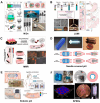Advances in Oral Biomacromolecule Therapies for Metabolic Diseases
- PMID: 40006605
- PMCID: PMC11859201
- DOI: 10.3390/pharmaceutics17020238
Advances in Oral Biomacromolecule Therapies for Metabolic Diseases
Abstract
Metabolic diseases like obesity and diabetes are on the rise, and therapies with biomacromolecules (such as proteins, peptides, antibodies, and oligonucleotides) play a crucial role in their treatment. However, these drugs are traditionally injected. For patients with chronic diseases (e.g., metabolic diseases), long-term injections are accompanied by inconvenience and low compliance. Oral administration is preferred, but the delivery of biomacromolecules is challenging due to gastrointestinal barriers. In this article, we introduce the available biomacromolecule drugs for the treatment of metabolic diseases. The gastrointestinal barriers to oral drug delivery and strategies to overcome these barriers are also explored. We then discuss strategies for alleviating metabolic defects, including glucose metabolism, lipid metabolism, and energy metabolism, with oral biomacromolecules such as insulin, glucagon-like peptide-1 receptor agonists, proprotein convertase subtilisin/kexin type 9 inhibitors, fibroblast growth factor 21 analogues, and peptide YY analogues.
Keywords: gastrointestinal tract; metabolic diseases; oral biomacromolecules; oral drug delivery.
Conflict of interest statement
The authors declare that there are no conflicts of interest.
Figures



Similar articles
-
Oral delivery of biomacromolecules by overcoming biological barriers in the gastrointestinal tract: an update.Expert Opin Drug Deliv. 2023 Jul-Dec;20(10):1333-1347. doi: 10.1080/17425247.2023.2231343. Epub 2023 Jul 13. Expert Opin Drug Deliv. 2023. PMID: 37439101 Review.
-
Differential Effects of Oral and Intravenous Lipid Administration on Key Molecules Related to Energy Homeostasis.J Clin Endocrinol Metab. 2016 May;101(5):1989-97. doi: 10.1210/jc.2015-4141. Epub 2016 Mar 10. J Clin Endocrinol Metab. 2016. PMID: 26964729 Free PMC article.
-
Ocular therapies with biomacromolecules: From local injection to eyedrop and emerging noninvasive delivery strategies.Adv Drug Deliv Rev. 2023 Jun;197:114864. doi: 10.1016/j.addr.2023.114864. Epub 2023 May 6. Adv Drug Deliv Rev. 2023. PMID: 37156266 Review.
-
From lipoprotein apheresis to proprotein convertase subtilisin/kexin type 9 inhibitors: Impact on low-density lipoprotein cholesterol and C-reactive protein levels in cardiovascular disease patients.Eur J Prev Cardiol. 2018 Nov;25(17):1843-1851. doi: 10.1177/2047487318792626. Epub 2018 Jul 30. Eur J Prev Cardiol. 2018. PMID: 30058841
-
Long-term exposure to air pollution raises circulating levels of proprotein convertase subtilisin/kexin type 9 in obese individuals.Eur J Prev Cardiol. 2019 Apr;26(6):578-588. doi: 10.1177/2047487318815320. Epub 2018 Nov 26. Eur J Prev Cardiol. 2019. PMID: 30477320
References
Publication types
Grants and funding
LinkOut - more resources
Full Text Sources

